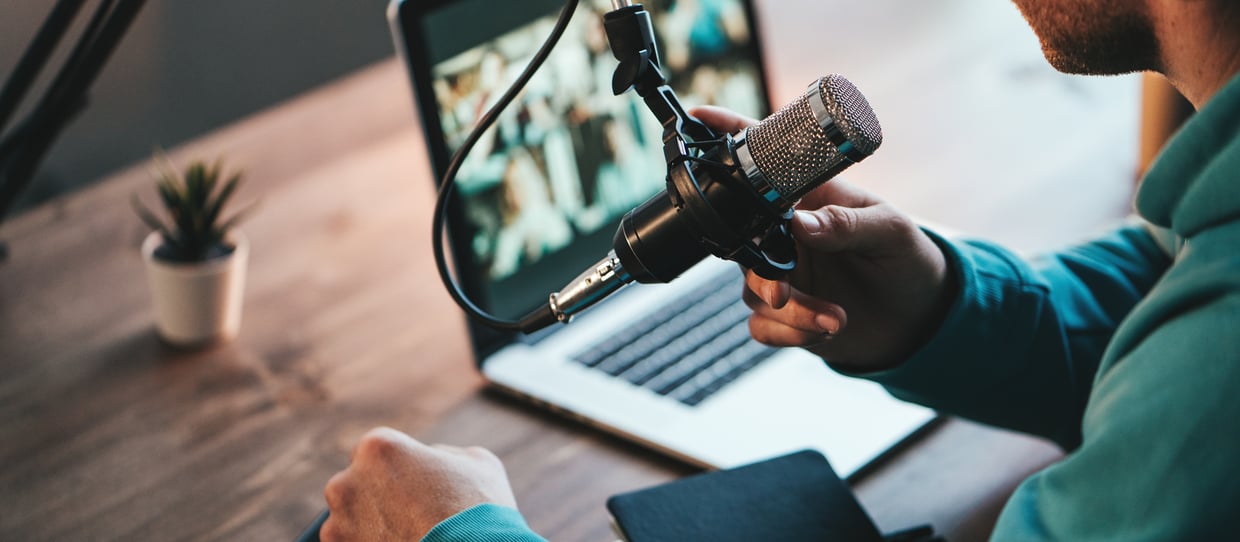‘
There was a sharp increase in the number of people listening to podcasts during lockdowns. This opened the door to a lucrative podcast advertising sector, with brands eager to reach highly engaged listeners. Many speculated, however, that listener numbers would decrease as the world opened back up – but that hasn’t happened.
Aren’t podcasts a thing of the past?
During the pandemic, there was a sharp increase in the number of people listening to podcasts, with lockdowns highlighting the human need for 1-1 connections – something a lot of listeners feel with their chosen podcast hosts. This increase was not expected to continue, with some even suggesting that, as life began returning to normal, podcasts would see a decline in their number of listeners. However, the opposite has happened. According to the latest Statistica statistics, global listener figures in 2020 were over 330 million, and are likely to rise to 500 million by 2024, with some podcasts reaching the same listener numbers as radio shows. These encouraging numbers are leading to approximately a 40% increase in podcast advertising spend in the UK, as shown in the IAB 2020 Digital Adspend report.
Podcasts are a prime place to advertise
Listeners’ relationships with podcasts are what makes them such an integral part of a digital advertising portfolio. With a defined listening pattern that compliments their daily routine, context is more important than ever. Due to the immersive nature of podcasts, the choice of podcast is likely linked to the listener’s mood. 45% of listeners say they’re more likely to buy a product if the audio connects with them in the right way. This means that brands need to pay close attention to all contextual factors.
By taking advantage of the listener’s emotional connection with audio content, brands can make themselves heard very effectively. Listening to music releases dopamine and so creates a relaxed mental state. By contrast, podcasts require a reasonable level of concentration. Listeners have an active interest in the podcast they’re listening to, meaning the mind is most receptive to advertising information. 76% of UK listeners have taken action after listening to a podcast, whether that’s making a purchase or visiting a site.
As a result of increasing privacy and tracking restrictions, there are challenges around increased personalization. This is an important aspect of digital audio ads. Some listeners say that they would be happy to receive personalized ads – so this must become a priority. With people now listening to digital audio on connected devices, advertisers are able to obtain greater access to first-party data. This first-party data gives brands more control over who hears their ad and when, thereby enhancing targeting precision.
Dynamic or host-read podcast advertising?
Although dynamically inserted ads are on the rise in podcasts, some agencies and brands are wary of this. There is concern that more dynamic ads could give podcasts a radio feel, diminishing the value of podcast ads. Dynamic ads do however make the process quicker and easier due by avoiding a long approval process. This method is the cheaper option and ads can also be trafficked in a more targeted way than host-read.
As previously mentioned, listeners feel they have a close relationship with the host of their chosen podcast. For this reason, host-read ads are likely to see the best performance. Not only do they promote authenticity, but they also avoid the abrupt change in voice of dynamic formats. This change indicates the start of the ad and therefore reduces the listener’s attention. There are drawbacks, however. These include the long lead times for approval, as well as the inability to trial an ad within the podcast. Host-read ads are more expensive as the host is paid to endorse the product, but they often see greater returns. A Nielsen study from 2020 found that host-read ads had a recall of 71%, compared to 62% for non-host-read. The best format, though, depends on both the type of product and the target audience.
Is podcast advertising an efficient way to reach consumers?
The pricing structure of digital audio advertisements is usually calculated using the cost-per-mile (CPM) model. This means that there is a fixed rate for every 1,000 listeners. Of course, there are numerous factors which will affect this rate. Some variables include the size of the podcast audience, which section of the podcast the ad will appear in and, of course, the length of the ad. AdvertiseCast released average rates based on nearly 3,000 podcasts; the CPM for a 30-second ad is $18 and for a 60-second ad it is $25. As previously mentioned, this does of course vary from podcast to podcast, with some instances even employing different pricing structures such as flat rate and CPA (cost per acquisition), but CPM is the most common.
Although it is the most comparable advertising type, radio advertising is open to more price variation than podcasts, making it difficult to compare pricing. The disparity in radio advert costs is due to the extreme number of differing options available, with region, time of day and the number of times per week having the greatest impact on price. So whilst it is difficult to make a price comparison between radio and podcasts, it is generally accepted that podcast ads are more effective than those on the radio: if they come at a premium, this may be worth it for the greater returns.
How can advertisers improve their podcast advertising experience?
For brands to ensure their podcast advertising is successful, they need to widen their audience by reaching hitherto untapped audiences. To do this, brands should look for more niche podcast genres and smaller shows. The top-rated podcasts currently have the majority of advertising. By targeting independent creators and micro-influencers, brands will be able to reach more diverse target groups.
Context is crucial when it comes to podcast ads. The nature of digital audio requires seamless positioning, so advertisers should ensure that the podcast’s content and host’s personality compliments their brand. With so many exciting creative opportunities in digital audio, there are endless avenues to explore to benefit from the exponential growth of podcasting.
Image: Alex From the Rock on Shutterstock




.png)




